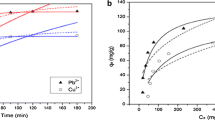Summary
Accumulation of cobalt (60Co) by the estuarine microalgaChlorella salina has been characterized. At cobalt concentrations ranging over 3.125–100 μM, a significant amount of cobalt was bound within 1 min. This was metabolism-independent and unaffected by incubation in light or dark conditions. This initial rapid phase of biosorption was followed by a slower phase of uptake which was apparently active and inhibited by incubation in the dark, or by the uncoupler dinitrophenol and the respiratory and photosynthetic inhibitor potassium cyanide in the light. For cells suspended in 10 mM Taps pH 8, cobalt biosorption followed a Freundlich adsorption isotherm. However, in the presence of 0.5 M NaCl, biosorption deviated from the Freundlich model because of competition by Na+. Cobalt biosorption was decreased by increasing concentrations of Na+, decreasing pH and the presence of Cs+, Li+, Rb+, Zn2+. Mn2+ and Sr2+ (added as chlorides). This was a result of competition between Co2+ and the other cations, including H+, for available binding sites on the cell wall and was confirmed by increased desorption of cobalt by solutions of low pH or high salinity. Increasing cell density resulted in increased removal of cobalt from solution but decreased the specific amount of cobalt taken up by the cells.
Similar content being viewed by others
References
Allen MM (1968) Simple conditions for the growth of unicellular blue-green algae on plates. J Phycol 4:l-13
Ashley NV, Pope NR, Roach DJW (1987) Department of the Environment: Commissioned research on radioactive waste management. DOE reference DOE/RW/88.008
Bold HC, Alexopoulus CS, Delevoryus T (1980) Morphology of plants and fungi. Harper & Row, New York
Broda E (1972) The uptake of heavy cationic trace elements by microorganisms. Ann Microbiol 22:93–108
Brinckman FE, Olson GJ (1988) Global biomethylation of the elements: its role in the biosphere translated to new organometallic chemistry and biotechnology. In: P. J. Craig, Glockling F (eds) The biological alkylation of heavy elements. Royal Society of Chemistry, London, pp 168–196
Campbell R (1983) Microbial ecology, Blackwell Scientific Publications, Oxford
Camplin WC, Mitchell NT, Leonard DRP, Jefferies DF (1986) Ministry of Agriculture, Food and Fisheries Aquatic Environment Monitoring Report 15: Radioactivity in surface and costal waters of the British Isles. Monitoring of fallout from the Chernobyl reactor accident. Her Majesty's Stationary Office, London
Clark RB (1989) Marine pollution. Clarendon Press, Oxford
Coleman RD, Coleman RL, Rice EL (1971) Zinc and cobalt bioconcentrations and toxicity in selected algal species. Bot Gaz 132:102–109
Crist RH, Oberholser K, Shank N, Nguyer M (1981) Nature of bonding between metallic ions and algal cell walls. Environ Sci Technol 13:1212–1217
Darnall DW, Greene B, Henzl MT, Hosea J, McPherson R, Sneddon J, Alexander MD (1986) Selective recovery of gold and other metal ions from algal biomass. Environ Sci Technol 20:206–208
Fisher NS, Bjerregaard P, Fowler SW (1983) Interactions of marine plankton with transuranic elements. l. Biokinetics of neptunium, plutonium, americium and californium in phytoplankton. Limnol Oceanogr 28:432–447
Fisher NS, Cochran JK, Krishnaswami S, Livingston HD (1988) Predicting the oceanic flux of radionuclides on sinking biogenic debris. Nature 335:622–625
Freundlich H (1926) Colloid and capillary chemistry. Methuen, London
Gadd GM (1988) Accumulation of metals by microorganisms and algae. In: Rehm H-J (ed) Biotechnology, vol 6b. VCH Verlagsgesellschaft, Weinheim, pp 401–433
Gadd GM (1990) Biosorption. Chem Ind 13:421–426
Greene B, Darnall DW (1990) Microbial oxygenic photoautotrophs (cyanobacteria and algae) for metal-ion binding. In: Ehrlich HL, Brierley CL (eds) Microbial mineral recovery. McGraw-Hill Publishing Company, New York, pp 227–302
Greene B, McPherson R, Darnall DW (1987) Algal sorbents for selective metal ion recovery. In: Patterson J, Pasino R (eds) Metal speciation, separation and recovery. Lewis, Michigan, pp 315–332
Greenwood NN, Eamshaw A (1984) Chemistry of the elements. Pergamon Press, Oxford
Hart BA, Scaife BD (1976) Toxicity and bioaccumulation of cadmium in Chlorella pyrenoidosa. Environ Res 14:401–413
Holm-Hansen O, Gerloff GC, Skoog F (1954) Cobalt as an essential element for blue-green algae. Physiol Plant 7:665–675
Horikoshi T, Nakajima A, Sakaguchi T (1978) Uptake of uranium byChlorella regularis. Agric Biol Chem 43:617–623
Khummongkol D, Canterford GS, Fryer C (1982) Accumulation of heavy metals in unicellular algae. Biotechnol Bioeng 4:2643–2660
Kuyucak N, Volesky B (1988) Accumulation of cobalt by marine algae. Biotechnol Bioeng 33:823–831
Mahan CA, Majidi V, Holcombe SA (1989) Evaluation of the metal uptake of several algal strains in a multicomponent matrix utilizing inductively coupled plasma emission spectrometry. Anal Chem 61:624–627
Mann H, Fyffe WS, Kerrich R (1988) The chemical content of algae and waters: bioconcentration. Tox Assess 3:1–16
Meikle AJ, Gadd GM, Reed RH (1990) Manipulation of yeast for transport studies: critical assessment of cultural and experimental procedures. Enzyme Microb Technol 12:865–872
Mellanby K (1980) The biology of pollution. Edward Arnold, London
Nakajima A, Horikoshi T, Sakaguchi T (1981) Studies on the accumulation of heavy metal elements in biological systems. XVIL Selective accumulation of heavy metal ions byChlorella regularis. Eur J App] Microbiol Biotechnol 12:76–83
Reed RH, Gadd GM (1990) Metal tolerance in eukaryotic and prokaryotic algae. In: Shaw J (eds) Heavy metal tolerance in plants: evolutionary aspects. CRC Press, Boca Raton FL, pp 105–118
Waterbury JB, Stanier RY (1978) Patterns of growth and development in pleuro-capsalean cyanobacteria. Microbiol Rev 42:214
Wong MH (1980) Toxic effects of cobalt and zinc toChlorella pyrenoidosa (26) in soft and hard water. Microbios 28:19–25
Wong KH, Chan KY, Ng SL (1979) Cadmium uptake by the unicellular algaChlorella saliva CU-1 from cultures with high salinity. Chemosphere 11/12:887–891
Author information
Authors and Affiliations
Rights and permissions
About this article
Cite this article
Garnham, G.W., Codd, G.A. & Gadd, G.M. Effect of salinity and pH on cobalt biosorption by the estuarine microalgaChlorella saliva . Biol Metals 4, 151–157 (1991). https://doi.org/10.1007/BF01141306
Received:
Issue Date:
DOI: https://doi.org/10.1007/BF01141306




